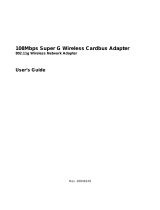Q2: Can find other networks, but cannot find my wireless network
1) Check the WLAN LED indicator on your wireless router/modem, and make sure it is on or
flashing. Check Wi-Fi On/Off button and make sure Wi-Fi is enabled.
2) Check whether you have disable the SSID broadcast on your router. If Hide SSID is
selected, you can’t find your networks any more.
3) Make sure your computer/device is still within the range of your router/modem. Try
moving closer if you are currently too far away.
4) Check the wireless router settings: your Wireless Name, whether the Region/Country is
selected correctly and wireless network is set to broadcast. Please contact your router’s support
for help if you are not sure how to check router’s settings.
Note: Different countries have different laws about wireless channels. For example, the USA
allows 2.4GHz channel from 1 to 11, while UK allows from 1 to 13. If you select the Region as
UK or the Channel as 12/13 while you are in USA, your computer might not be able to pick up
the signal. For more information, please click here.
Q3: Can find my wireless network, but cannot connect to it
1) Authenticating problem, password mismatch
Sometimes it will ask you to type in a PIN number when you connect to the wireless network for
the first time. This PIN number is different from the Wireless Password/Network Security Key.






















